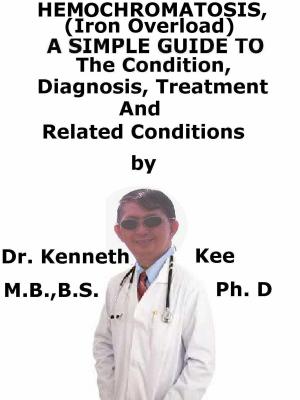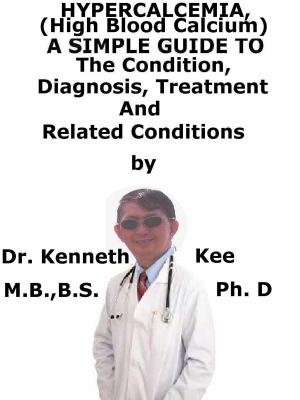Leukocytosis, A Simple Guide To The Condition, Diagnosis, Treatment And Related Conditions
Nonfiction, Health & Well Being, Medical, Specialties, Internal Medicine, Hematology| Author: | Kenneth Kee | ISBN: | 9781370381104 |
| Publisher: | Kenneth Kee | Publication: | November 17, 2016 |
| Imprint: | Smashwords Edition | Language: | English |
| Author: | Kenneth Kee |
| ISBN: | 9781370381104 |
| Publisher: | Kenneth Kee |
| Publication: | November 17, 2016 |
| Imprint: | Smashwords Edition |
| Language: | English |
Leukocytosis is a medical disorder when the white blood cell count (the leukocyte count) is higher than the normal range in the blood
High white blood cell count is a higher amount in disease-fighting cells (leukocytes) circulating in the blood.
Leukocytosis is frequently a sign of the inflammatory response most commonly due to infection, but may also happen after certain parasitic infections or bone tumors.
It may also happen after convulsions such as epilepsy, emotional stress, strenuous exercise, pregnancy and labor, anesthesia, and epinephrine injection.
A high white blood cell count normally suggests a:
1. Raised production of white blood cells to fight an infection
2. Reaction to a drug that increases white blood cell production
3. Disorder of bone marrow, resulting in abnormally high production of white blood cells
4. Immune system disorder that produces higher white blood cell production
There are five principal types of leukocytosis:
1. Neutrophilia (the most common form)
2. Lymphocytosis
3. Monocytosis
4. Eosinophilia
5. Basophilia
The mechanism that produces leukocytosis can be of several forms:
1. A higher release of leukocytes from bone marrow storage pools,
2. Decreased margination of leukocytes onto vessel walls,
3. Decreased extravasation of leukocytes from the vessels into tissues,
4. An increase in amount of precursor cells in the marrow
Certain medicines may cause leukocytosis including:
1. Corticosteroids,
2. Lithium
3. Beta agonists
A high white blood cell count of more than 11,000 leukocytes in a micro-liter of blood in adults is normally considered leukocytosis.
The high end for a high white blood cell count in children depends on the child’s age and size
Leukapheresis or exchange blood transfusion is a treatment of choice for this purpose with:
1. Hydration,
2. Urine alkalinization,
3. Administration of rasburicase (uric acid oxydase) or allopurinol to decrease blood uric acid and minimize tumor lysis syndrome.
When rasburicase is used, urine alkalinization is not recommended.
Definitive treatment of underlying cause is promptly instituted with appropriate chemotherapy
TABLE OF CONTENT
Introduction
Chapter 1 Leukocytosis
Chapter 2 Causes
Chapter 3 Symptoms
Chapter 4 Diagnosis
Chapter 5 Treatment
Chapter 6 Prognosis
Chapter 7 Eosinophilia
Chapter 8 Leukemia
Epilogue
Leukocytosis is a medical disorder when the white blood cell count (the leukocyte count) is higher than the normal range in the blood
High white blood cell count is a higher amount in disease-fighting cells (leukocytes) circulating in the blood.
Leukocytosis is frequently a sign of the inflammatory response most commonly due to infection, but may also happen after certain parasitic infections or bone tumors.
It may also happen after convulsions such as epilepsy, emotional stress, strenuous exercise, pregnancy and labor, anesthesia, and epinephrine injection.
A high white blood cell count normally suggests a:
1. Raised production of white blood cells to fight an infection
2. Reaction to a drug that increases white blood cell production
3. Disorder of bone marrow, resulting in abnormally high production of white blood cells
4. Immune system disorder that produces higher white blood cell production
There are five principal types of leukocytosis:
1. Neutrophilia (the most common form)
2. Lymphocytosis
3. Monocytosis
4. Eosinophilia
5. Basophilia
The mechanism that produces leukocytosis can be of several forms:
1. A higher release of leukocytes from bone marrow storage pools,
2. Decreased margination of leukocytes onto vessel walls,
3. Decreased extravasation of leukocytes from the vessels into tissues,
4. An increase in amount of precursor cells in the marrow
Certain medicines may cause leukocytosis including:
1. Corticosteroids,
2. Lithium
3. Beta agonists
A high white blood cell count of more than 11,000 leukocytes in a micro-liter of blood in adults is normally considered leukocytosis.
The high end for a high white blood cell count in children depends on the child’s age and size
Leukapheresis or exchange blood transfusion is a treatment of choice for this purpose with:
1. Hydration,
2. Urine alkalinization,
3. Administration of rasburicase (uric acid oxydase) or allopurinol to decrease blood uric acid and minimize tumor lysis syndrome.
When rasburicase is used, urine alkalinization is not recommended.
Definitive treatment of underlying cause is promptly instituted with appropriate chemotherapy
TABLE OF CONTENT
Introduction
Chapter 1 Leukocytosis
Chapter 2 Causes
Chapter 3 Symptoms
Chapter 4 Diagnosis
Chapter 5 Treatment
Chapter 6 Prognosis
Chapter 7 Eosinophilia
Chapter 8 Leukemia
Epilogue















